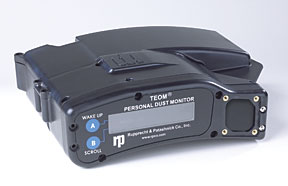11th Circuit Rejects Coal Industry’s Challenge to MSHA’s Dust Rule (National Mining Association v. Secretary)

Personal dust monitor that measures levels of respirable coal dust. Source: www.rtpcompany.com
Breaking news: The U.S. Court of Appeals for the 11th Circuit rejected the coal industry’s challenge to the 2014 dust rule by the U.S. Department of Labor’s Mine Safety and Health Administration.
In an 83-page opinion in National Mining Association v. Secretary, 812 F.3d 843 (11th Cir. 2016) (slip opinion available here), authored by Senior Circuit Judge Ripple (of the Seventh Circuit) and joined by Circuit Judge Wilson and Senior Circuit Judge Fay (of the Eleventh Circuit), the court rejected the petitions for review brought by coal industry groups led by the National Mining Association and Murray Energy.
The main takeaway from this opinion is the bottom-line: MSHA’s dust rule has withstood judicial scrutiny. As a result, the next phase of the rule will be implemented, as scheduled, next week. On February 1st, coal operators must begin providing continuous personal dust monitors (CPDMs) to the dustiest jobs on each section and the frequency of sampling will increase. Then in August 2016, the dust limit will decrease by 25% from 2.0 mg/m3 to 1.5mg/m3. (For a previous post about the dust rule, see here.)
(Disclosure: The law firm that publishes this blog, Appalachian Citizens’ Law Center, represented the National Black Lung Association and the National Coalition of Black Lung and Respiratory Disease Clinics in their amicus brief for this case—a copy of which is embedded at the end of this post. However, the Eleventh Circuit denied the requests from our clients and the United Mine Workers’ of America to have their briefs considered, so our role was limited.)
Court Opinion
Judge Ripple’s opinion provided a lengthy background of federal efforts to regulate respirable coal-mine dust. With this background in mind, Judge Ripple then addressed the industry’s challenges.
The industry’s first argument was a formal, procedural challenge to the rule. The groups argued that the Secretary of Labor needed to jointly promulgate the rule with the Secretary of Health and Human Services (HHS), and the failure of HHS to be a signatory on the Notice of Proposed Rulemaking and Final Rule means that the rule cannot be valid. The court rejected this challenge, relying on the 11th Circuit’s 1998 decision in National Mining Association v. Secretary of Labor, 153 F.3d 1264 (11th Cir. 1998). At note 21 of today’s decision, the court said “we note the irony of the petitioner’s position” considering that groups such as the National Mining Association successfully argued for interpretation of the Mine Act that led to their current challenge being rejected.
The industry’s second argument substantively asserted that MSHA’s rule was irrational and not based upon the best available evidence. The court rejected this argument as well, noting that MSHA supported its rule with a lengthy record developed over the course of years of efforts and that MSHA deserved deference from the court given MSHA’s technical expertise. In addition, the court noted that the Mine Act is meant to prioritize the health and safety of miners. Over about forty pages, the court analyzed each of the industry’s substantive challenges and in the end concluded, among other things, that single-shift sampling is proper, that the continuous personal dust monitor is sufficiently accurate and reliable, and that MSHA’s economic analysis of the new rule’s feasibility fulfilled the agency’s responsibility. The court affirmed MSHA’s determination that the actual costs “can hardly be characterized as so high as to threaten the existence or the competitive structure of the industry.”
Analysis
Today’s decision is a significant, lasting win for MSHA and the right of coal miners to work in safe conditions. The decision will have a nationwide impact and ensures that MSHA and the coal industry will continue to phase-in the new dust rule’s requirements in coming years.
Beyond the text of today’s decision, it is interesting that Judge Ripple, who was sitting on the Eleventh Circuit by designation, took up the authorship of this decision. During Judge Ripple’s 30-plus years on the Seventh Circuit, he participated in many black lung benefits cases (at least 8 by a quick search). On the other hand, I am not aware of any black lung cases that Judge Wilson has presided over and only two that Judge Fay rule on: one in 1977 and another in 1988. I can’t help but think that a judge who has decade-in, decade-out heard cases involving miners disabled by black lung under modern dust conditions might have those cases in mind as he considered the industry’s challenge to a rule meant to better protect miners.
This is not to say that one needed to look beyond the Mine Act and MSHA’s rulemaking record to uphold the dust rule. But considering the importance that today’s decision put on a contextual analysis of the Mine Act’s provisions, one has to think of the larger context of the dust rule and what it means for our Nation’s miners. And in that larger context, today’s decision is a major win in the efforts to end black lung.
Below is a copy of the amicus brief.
3 Responses to “11th Circuit Rejects Coal Industry’s Challenge to MSHA’s Dust Rule (National Mining Association v. Secretary)”
Nice work guys on the Amicus Brief!
Thanks! The real compliments should go to Joe Main for his dedication to getting the dust rule finalized and the Department of Labor’s lawyers for skillfully defending it.
[…] 2016, Murray Energy unsuccessfully sued the government in an effort to stop the dust control rule. In a written statement, the company said it is pleased […]
Comments are closed.